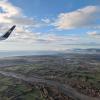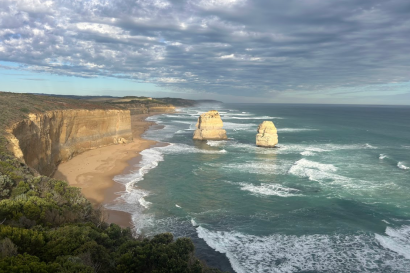Two weeks ago, as I looked at my semester calendar, I noticed that my remaining time in NZ is dwindling down at an alarming rate. And there's still so much I want to do! However, one particular trip I had been thinking about doing for a while was a journey down to Stewart Island. Two weeks ago, looking at how little time I had left, I realized it was now or never for that trip, so I chose the now. Last minute trip planning is never my first choice, but I'm so glad I took the leap. I booked my bus, shuttle, ferry, and hut bunks, and scored a nice pair of gaiters on Facebook Marketplace. I was ready to go to Rakiura/Stewart Island.
Rakiura is Aotearoa’s third largest island, located just off the southern tip of the South Island. Because of its remoteness, it has been less disturbed than areas on the mainland, although part of it was still cleared by the timber industry. How you could look at such a gorgeous island landscape with beautiful native bush that houses countless endemic species and think, "Here's a great idea, I'll chop this down so I can make money" is beyond me, but that's what they did for several years. However, the rest of the island, while still facing its share of invasive pests and plants, feels a lot wilder and undisturbed. Even compared to "wilderness" areas on the mainland, it just feels more like a true bush, with thick trees and vines and mud, and a multi-layered canopy overhead, creating shadowy twilight lighting over the massive ferns below.
To get the most out of my time on the island, I booked the Rakiura Track, another Great Walk, completed as a 39 km loop from Oban (the main township on the island). It crosses beach and bush on both DOC land and Rakiura Māori land, where access is generously granted by the local Rakiura Māori. It was a wonderful three day adventure, and here are some highlights from the trip:
- Classic Kiwi Hospitality: I spent the night before I started the track in the town of Invercargill, way at the southern tip of the South Island, in a hostel-like accommodation where I had my own room. The owner, Carol, was such a great host she gets her very own bullet point in this post. Not only did she pick me up and drop me off at my bus out of the goodness of her heart, she also gave me great local tips about the area, and when I mentioned going to get takeout, she encouraged me to make myself at home in the living room so I could "watch some telly" while I ate. After I did so, she came in and recommended an Australian TV show that was just about to come on, that she herself was going to watch in the other room. It was called Travel Guides and was a comical reality show featuring some personality-filled Aussies. Every time something funny happened in the show, I could faintly hear Carol cracking up in the next room. We parted ways the next day, after she made sure I had her personal phone number so I could text her directly if I was ever back in town. Thanks Carol!
- A Bumpy Ride: The ferry ride from Bluff (at the verrrryyy end of the South Island) to Rakiura is infamously rough, especially if the wind is blowing the right way. Sure enough, as soon as we got going I thought "wow, yes, this is pretty rocking and rolling" and the woman next to me had already closed her eyes, with her hands clenched on the seat in front of her. And that's when I realized we hadn't even left the harbor yet! Thankfully, the pitching and rolling and slamming down on the other side of each wave didn't last the whole time, and then it was reasonably smooth sailing to the island. Double thankfully, I am not known to get sea sick, but I have to admit that even I had a bit of a headache after a while. Unless you're like the seasoned folks I saw on the ferry, calmly sipping a beer in their weathered jackets and hats as the boat rolled up and down, maybe pack some Dramamine for this trip!
- Birds in abundance: For those of you who don't know, I'm a huge bird nerd and the possibility of seeing some unusual birds in the wild was a main reason I booked this trip. It did not disappoint. Due to large tracts of the native bush still being in good shape and control measures against invasive predators, the sound of feathers and bird song was much more common in Rakiura than any other bush areas I've visited here. The Tui, an iridescently colored bird with distinctive puffs of white feathers on its breast, was especially present. The whistles of Bell Birds and persistent cheeps of Fantails also called out. I was especially excited to come across many Red-Crowned Parakeets, who exhibited the same agility and adorable behavior as the smaller budgie parakeets I used to have as pets. My most exciting sighting was that of a Kākā, a massive bush parrot similar to a Kea, but more olive/brown than green, and with a different range. I was only alerted to its presence by hearing the snap of it cracking open some seeds with its long, curved beak. I was able to watch in amazement as it climbed around in the top of the canopy and even swooped by to a neighboring tree, occasionally showing me its vivid crimson breast.
- ….but no Kiwis: Rakiura has a reputation for being one of, if not THE, best places to see Kiwis in the wild. The largest species resides there and is often sighted by those tramping the Rakiura Track. The Kiwis must have decided to play hide and seek with me though, and unfortunately I did not win. Another woman I met on the track saw them three separate times, twice on evening trips to the long drop (toilet) and once in broad daylight along the same track I walked. I went out both nights and early one morning with my red filtered flashlight (to minimize disturbance, since Kiwi can't really see the red light spectrum and bright white light scares them) but no luck. The closest I got was hearing a male's slightly eerie, piping call, which sounded a bit like a child blowing too hard on a recorder. That alone was such a cool experience, but of course the vocal Kiwi had disappeared into the bush by the time I tiptoed over there. There was also a dramatic moment where I heard some snuffling in the bush, a branch quivered…and out stepped a possum. Not what I was looking for. Of course I was disappointed about missing the Kiwi, but they are wildlife after all, and primarily nocturnal wildlife at that. Part of the magic of looking for them is that if you do see them, it's because they chose to be there, not because they're fenced into a display. I'll have to catch you next time, Kiwis.
- They weren’t lying about the mud: The DOC page about the Rakiura Track doesn't mince words when it talks about the possibility of long stretches of this temperate rainforest track being covered in deeper-than-boot-height mud—hence why I brought some gaiters to help cover the gap between my ankle and my boot and keep my socks dry. The wonderful Anne at the DOC Rakiura visitor center affirmed this choice and said I should “wear ‘em if you’ve got ‘em” about my gaiters. As a side note, if you do a Great Walk (or really any tramp in a new area in NZ) I highly recommend checking in at the DOC visitor center before you start. The rangers have always been super helpful and they know the most up-to-date info about the weather and the tracks themselves, so you can avoid unfortunate surprises. They can also check you in for your hut reservations and confirm you have the gear you need. Anne also gave me some helpful directions for getting to and from the track, since I would be walking the 5 km to the trailhead from the main township. Anyway, the mud. Starting on day 2, it made itself known. Some sections you could easily circumnavigate or there were helpful logs or rocks to step across on. At first I thought I could get away with not wearing the gaiters and just finding creative ways across. And I did get quite good at balance-beaming across logs and doing intricate dances over the slop on small islands of rock and vegetation, but then it got soupier and soupier and soupier. And there was no sign of it drying up further ahead. Soon my stubbornness about not wanting to wear gaiters unless I "really had to" was completely worn down, so I strapped them on. With the gaiters on, I could afford to walk right through the central (but much muddier) part of the track, so I made much better time. There were still a few times where I stepped in an innocent looking patch of mud a little deeper than expected. Usually this resulted in me trying to yank my foot out as quickly as possible, invoking a loud squelch and a feeling like my shoe was about to be sucked off, causing me to do a comical stumbling dance to regain my balance. Proud to say I never actually fell down but there were definitely some slippery, sloggy bits. Honestly I didn't really mind it though; it added adventure to the track, my socks stayed reasonably dry, and I'm sure my stumbling and squelching around provided some great entertainment for any birds that were watching.
- The lowdown on the huts: The two huts I stayed in, North Arm hut and Port William/Potirepo hut, were both less luxurious (and cheaper) than the Kepler huts, due to less popularity and it being the off season. They each had 24 bunks but there were only 5-10 other people staying there with me each night. Everyone was incredibly nice and I enjoyed getting to know them more, especially a couple from the Netherlands and three ICU nurses from Christchurch.
- A track with an ocean view: One of my favorite parts of this track was how much it followed the coast. The views over the water at all times of the day were gorgeous and one section of the track even walked right along a beach, so of course I took off my socks and shoes and walked in the surf for that part. The chilly water felt so good on my sore feet. The hut I stayed at that night was right along the shore, and I was inspired by one of my hut-mates to go for a quick dip before changing into my hut clothes. As you can imagine, ocean water that far south in the fall is a little chilly, but was nothing that swimming in Black Hills' lakes hadn't prepared me for. Even a very quick dunk was invigorating and made the outside air feel positively balmy. The downside was that my hair was then encrusted with sea salt for the remaining two and a half days until I reached a shower, but it was worth it. Another interesting thing about Rakiura waters is that they contain sea lions, who can apparently be a little aggressive if disturbed. I asked Anne to confirm that the sea lions would only be along the beaches and she said, "oh no, they come up into the bush as well, they know how to climb the stairs". It was a little alarming to consider encountering an angry sea lion in the middle of the dense bush, but I didn't see one the whole time I was there, on the beach or otherwise.
- Boat breakdown deja vu: The hour ferry ride back was going super breezy until about half-way across. Then, the captain shut down the engine and said "don't worry folks, just need to check something with the engine real quick". Where have we heard THAT before?? Sure enough, the "don't worry" turned into a "do worry" after the captain came back and reported there was a gasoline leak, so we would have to return on the power of just one engine. I was sitting with the same couple from the Netherlands who I had shared a hut with, and after telling them of my similar experience on a boat while doing the Kepler track, they were joking about throwing me overboard due to being "bad boat luck". However, I was lucky enough that we didn't have to get towed, and we made it to the harbor on one engine, with only an hour delay. I wish I could say I’m not planning any future trips involving a boat, but considering I'm on an island with a high number of tracks that are reached by water taxi/ferry, the odds are high I will find myself on a boat again soon. Fingers crossed the engine trouble trend won’t continue.
My time on Stewart Island, while short, will definitely go down as one of my favorite experiences while here in Aotearoa. Even the rougher parts, like the boat and the mud, add to its memorableness, and I feel fortunate to have been able to visit such a remote and wild area. Until next time, if you see any Kiwis, send them my way!
Cheers!
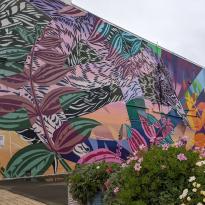
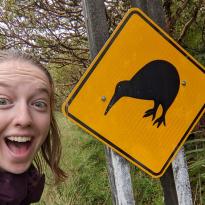
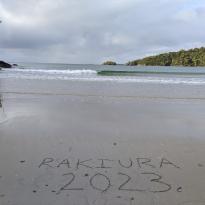
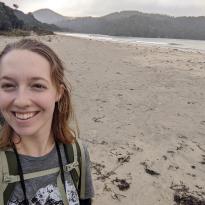
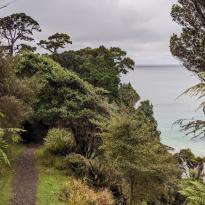
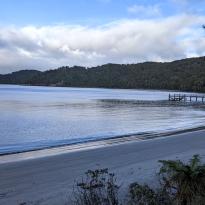
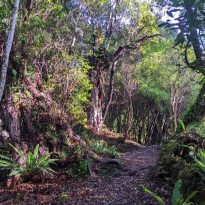

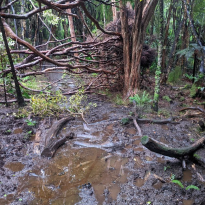
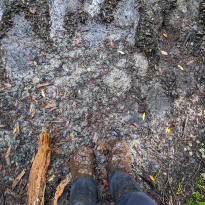
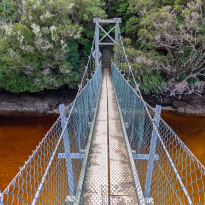

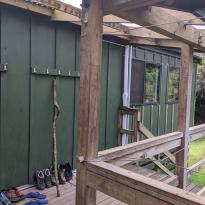
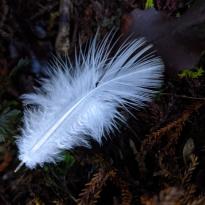
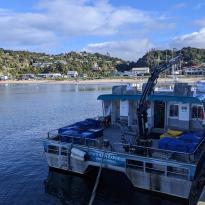


Anna Marie Riner
Kia ora! My name is Anna Marie, and I am a creative, outdoorsy individual from the Black Hills in South Dakota. This semester, I'm excited to be crossing the globe to New Zealand for some studying, tramping (hiking), eating, birding, interning, exploring and much more.



















